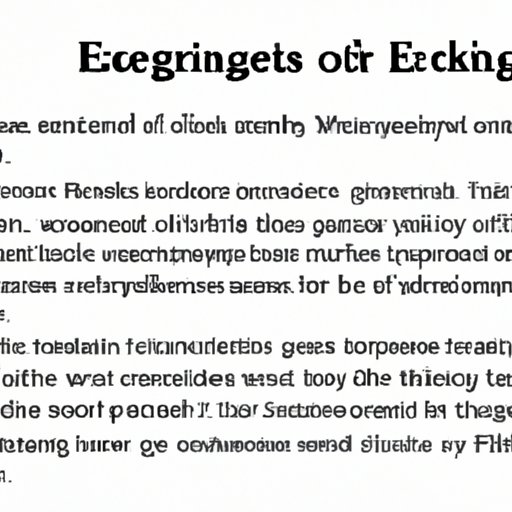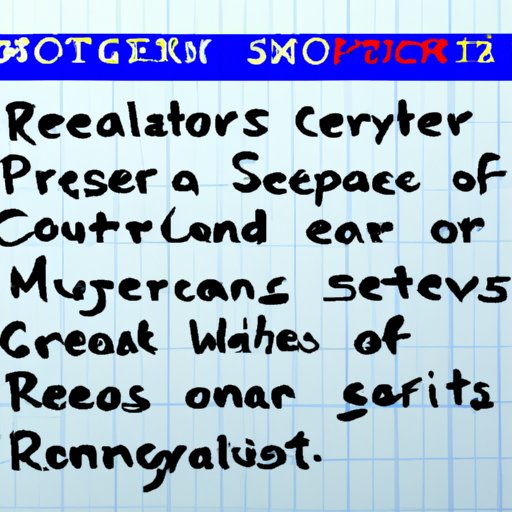Introduction
Mechanical errors refer to mistakes made in the structure, grammar, punctuation, or spelling of written text. These errors can be found in both formal and informal writing, such as essays, reports, emails, and social media posts. In this article, we will explore the different types of mechanical errors, their causes, and how to recognize and avoid them.

Exploring the Types and Causes of Mechanical Errors in Writing
Grammatical errors are one of the most common types of mechanical errors. These include mistakes in subject-verb agreement, verb tense, word choice, and sentence structure. For example, a sentence may contain incorrect verb conjugation, incorrect use of articles, or incorrect use of pronouns. Punctuation errors refer to mistakes in the use of commas, periods, semi-colons, colons, and other punctuation marks. Spelling errors involve incorrect spelling of words or incorrect use of homophones.
Common causes of mechanical errors include poor proofreading, lack of knowledge about grammar and punctuation rules, and carelessness. Other causes include using unfamiliar words or phrases, misreading source texts, and relying too heavily on automated spell-checkers. Mechanical errors can also be caused by distractions or fatigue.

Recognizing and Avoiding Common Mechanical Mistakes in Writing
The best way to avoid making mechanical errors is to proofread your work carefully before submitting it. If possible, have someone else review your work for errors. When proofreading, take your time and read each sentence slowly, paying close attention to grammar, punctuation, and spelling. You should also look out for common errors, such as mixing up homophones (e.g., they’re/their/there), using the wrong form of a word (e.g., accept/except), and leaving out articles (e.g., a/an/the).
Another strategy for avoiding mechanical errors is to use reliable sources when researching topics. Make sure that you double-check any facts or figures you include in your writing. Additionally, use a dictionary or thesaurus to look up the meanings and spellings of unfamiliar words. Finally, if you find yourself getting distracted or tired while writing, take a break and come back to it later.
Understanding How to Correct Mechanical Errors in Writing
Once you’ve identified a mechanical error in your writing, you need to know how to fix it. The first step is to reread the sentence or paragraph in which the error occurred. This will help you understand why the mistake was made and how to fix it. If you are unsure of the correct grammar, punctuation, or spelling, consult a reliable source such as a dictionary or style guide.
You should also consider using a proofreading tool to check your work for errors. These tools can be particularly helpful for identifying common mistakes such as typos and misspellings. However, it’s important to remember that these tools cannot catch all errors, so you should still proofread your work manually.

Analyzing the Impact of Mechanical Errors on Effective Communication
Mechanical errors can have a significant impact on the effectiveness of your writing. Poorly written text can make it difficult for readers to understand your message, and it can also create a negative impression of you as a writer. To ensure that your writing is clear and accurate, it’s important to take the time to proofread your work and identify any errors.
It’s also important to remember that mechanical errors are just one type of writing error. Other types of errors include factual inaccuracies, logical inconsistencies, and stylistic issues. To ensure that your writing is clear, accurate, and well-written, it’s important to be aware of all types of errors and to take steps to avoid them.
Conclusion
In summary, mechanical errors are mistakes made in the structure, grammar, punctuation, or spelling of written text. They can have a significant impact on the effectiveness of your writing, so it’s important to take the time to proofread your work and identify any errors. Additionally, it’s important to be aware of other types of writing errors and to take steps to avoid them. With careful proofreading and attention to detail, you can ensure that your writing is clear and accurate.
(Note: Is this article not meeting your expectations? Do you have knowledge or insights to share? Unlock new opportunities and expand your reach by joining our authors team. Click Registration to join us and share your expertise with our readers.)
